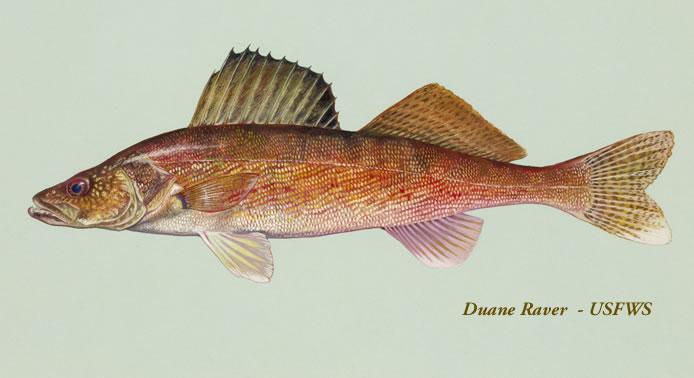Following an October 2022 netting survey of Banks Lake in Grant County, WDFW has released 2023 Banks Lake Walleye Fishing Prospects (PDF).
Description and Range
Physical description
Walleye have one of the most dedicated angler followings in the state because they can be a challenge to catch and they are one of the best eating freshwater fish anywhere. They are a member of the perch family, and so they are closely related to yellow perch. Their most distinguishing features are: two separate dorsal fins with a dark spot near the base of the spiny first dorsal. They also have prominent canine teeth and the lower lobe of the tail fin has a white margin. Walleye also do not have the dark vertical bars on a yellow-golden background on their sides that are features of yellow perch. Average 16-25 inches (2-12 lbs.). Walleye can grow to 20-30 inches (5-15 lbs.) in quality populations.
Where you may encounter walleye
Lakes where this species may be found
How to fish for walleye
Fishing prospects calendar
There are three secrets to catching walleyes (at least): fish on the bottom; fish slowly; and use night crawlers. The first two of these are the most important. Walleyes stay close to the bottom, and they do not spend a lot of energy chasing their food. The most consistent fishing depth during daytime is 18 to 25 feet. Rocky bottoms are usually preferred, with a nearby depth change or "break-line" a desirable feature. Good catches can also be made in or around weed beds at certain times.
A good walleye rig is one that can be cast or trolled slowly along the bottom without getting hung up too often. Although not necessary, a stout wire leader 12 inches above the hook will protect the line from abrasive rocks, and will keep the walleye's sharp teeth from cutting the line once the fish is hooked but a heavy leader may make your offering less attractive to the fish.
Many kinds of lures, jigs, spinners and spoons will fool walleyes, with most of them being much more effective if a live night crawler is attached. Trollers will often put a worm on a stout, sharp 1/0 hook attached to a flashy spinner with a wire leader tied to a good swivel. Eighteen inches in front of the swivel they will put a small split shot that will keep a one to two-ounce barrel weight in place. Casters must use a lure that is heavy enough to sink rapidly to the bottom.
Large deep-diving plugs are also a popular and productive technique. These are usually in bright colors that will show up in the depths, and are trolled without any bait attached.
Whatever bait or lure is used, it's important to fish very slowly. Some anglers even troll in reverse (when it is safe to do so) to get their speed down to what a walleye will chase. Once a walleye is caught, continue fishing the same area. Where there is one there will usually be more. Also make note of the bottom or "structure" and look for fish in similar habitat.
Two final tips: keep the hooks razor sharp and try fishing at night. In addition to a mouthful of teeth, walleyes have a hard, bony palate to protect themselves from the spines of the fish they eat. A sharp hook is mandatory to getting a solid hookup. And in the Midwest, where walleye are native, and truly king, many anglers find great success fishing at night when walleye are naturally active, due to their ability to see in low light conditions.
State record
- Weight
- 20.32 lbs
- Angler
- John Grubenhoff
- Location
- Lake Wallula, Benton County
- Date Caught
- February 28, 2014
